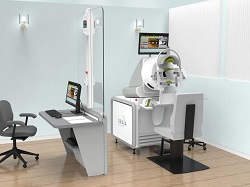 |
| Oraya's X-ray system |
Ophthalmology company Oraya Therapeutics will collaborate with researchers from Boston's Dana-Farber Cancer Institute to study applications of its novel radiation therapy against cancer when used in conjunction with gold nanoparticles. The partnership will be supported by a $215,000 small business technology transfer grant from the U.S. National Institutes of Health.
Oraya developed its low-voltage X-ray system to treat wet age-related macular degeneration--the leading cause of blindness in the developed world--and is expanding its presence in Europe. The research could lead to further improvements in its existing delivery system for the treatment of that condition as well.
"With this grant we hope to demonstrate that high concentrations of gold nanoparticles can be targeted to CNV (choroidal neovascularization) endothelial cells without damaging surrounding ocular tissue, and ultimately pursue further research that could lead to the commercialization of new cancer and wet AMD treatments," said Mike Makrigiorgos, a professor of medical physics and biophysics at the Dana-Farber Cancer Institute and Harvard Medical School, in an Aug. 5 statement.
The researchers envision intravenously delivering tagged gold nanoparticles that will attach to diseased lesions in the eye. Then the targeted X-ray beams will cause the nanoparticles to release electrons over a short distance that will damage diseased cells. The method can be used to treat both wet AMD and eye cancer, the release says.
Prior to the development of Oraya's radiation delivery technology, "the ability to deliver a targeted dose of radiation to the precise point in the eye was seemingly insurmountable," Oraya Therapeutics CEO Jim Taylor said during a recent interview with FierceMedicalDevices, noting that the macula, located in the back of the eye, is a small (4-millimeter) and moving target. But he said Oraya overcame the technical and scientific challenges through advanced robotics, a laser-guided positioning system and a patented methodology for eye stabilization and tracking.
Because radiation targets cells that are in the process of dividing, and normal retinal cells are some of the slowest to divide while the endothelial cells in the neovascular complex are often dividing, the therapy is naturally targeted toward diseased parts of the eye rather than healthy tissue, Taylor explained.
In July, Oraya announced that 5 European hospitals are offering a 20-minute noninvasive surgery for wet AMD using its X-ray system, joining a hospital in Switzerland that has offered the therapy since 2013. And thanks to the NIH grant, the company is joining the fight against cancer as well.
- read the release about the NIH grant (PDF)